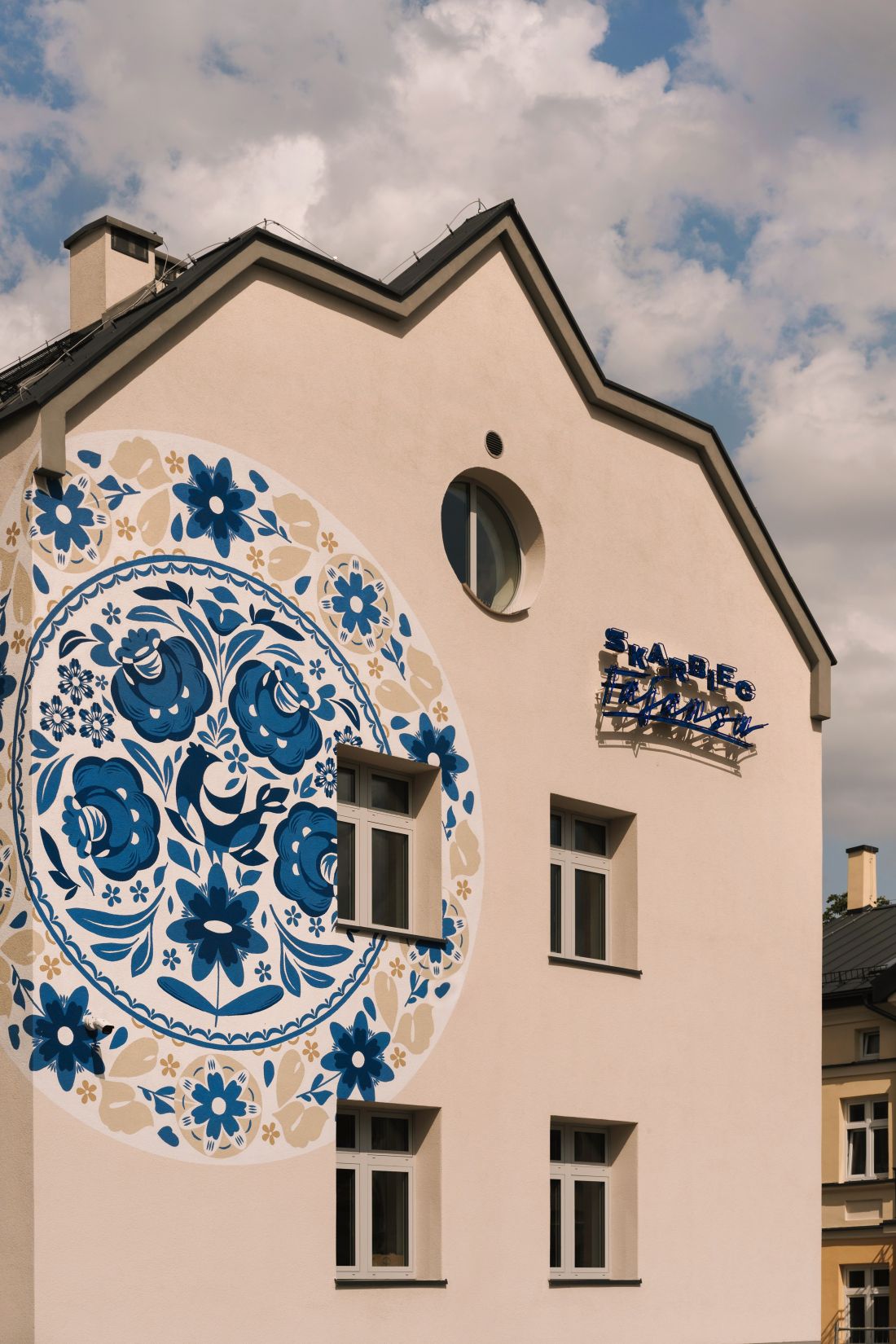An Interactive Center Treasury of Faience has opened in Włocławek. Visitors can learn about the 150-year tradition of Włocławek's ceramics, its flagship works, play games, decorate dishes with multimedia, and take part in workshops. This space with cobalt accents and a permanent exhibition designed by Koza Nostra Studio received an honorable mention in this year's Art in Architecture Festival competition.
The Treasury of Faience Educational Center is located in Włocławek at the intersection of Żabia and Królewiecka Streets and is housed in a historic bank building. Its interior, which has been worked on by artists and designers from many fields, includes interactive historical, educational, exhibition and commercial-sales zones. Art sections and ceramic workshops starring faience are also planned.
The historic, glazed stained-glass skylight above the main exhibition hall is a unique place
Photo: Almond Studio © Koza Nostra Studio
The Treasury Center is an amphitheater with a stained-glass skylight, where the most important works of Włocławek ceramics are on permanent display. Interactive educational and exhibition spaces, are divided into pathways, adapted to the age of visitors.
Bartek Bojarczuk's mural and cobalt interior
Photo: Migdał Studio © Koza Nostra Studio
The color scheme of the entire arrangement was narrowed down by the designers to the colors used to decorate faience. These include cobalts, ochres and whites, which can be found both in the exhibition and in the specially designed visual identity. The characteristic patterns and colors are the motif of a mural, visible on the facade of the Center, created by graphic designer Bartek Bojarczuk.
At the exhibition we will learn the secrets of faience production
Photo: Migdał Studio © Koza Nostra Studio
conversation with Koza Nostra Studio
Dobrawa Bies: We're talking about the permanent exhibition you designed for the Treasury of Faience Educational Center. How did it come about that Koza Nostra Studio co-authored it?
Natalia Horak: The Koza Nostra studio entered an open design competition and won it. That's where we get most of our commissions.
Dobrawa: The exhibition is the result of collaboration between people from different fields: architecture, multimedia, scenography, graphic design. How did you work with such a large group?
Natalia Horak: We have been working in such teams for more than 8 years. It's a great adventure every time. Each of the creators has his own world, we inspire each other and a completely new quality comes into being, surprising us all! For me, it is this creative interdisciplinarity that is the reason why I still enjoy exhibition design so much. Of course, there is always a leader whose vision everyone follows, otherwise creative collaboration would quickly turn into creative chaos.
exhibition Treasury of Faience
Photo: Migdał Studio © Koza Nostra Studio
Dobrawa: Did the historic bank building, where the exhibition is located, influence its realization?
Natalia Horak: This historic building completely impressed us already at the competition stage. The historic stained glass skylight above the main exhibition hall is a unique place. It's not often that the exhibition space naturally has such an interesting concentric layout and such perfectly soft gallery lighting.
patterns are mapped on the ceramics
Photo: Almond Studio © Koza Nostra Studio
Dobrawa: What was the key that guided you in creating the exhibition? What story did you want to convey to visitors? Does its tour follow a specific path?
Natalia Horak: The basis for the design was a very precise scenario written by our experts in consultation with local specialists. The tour path heads to a central point under the skylight, where the most interesting exhibits in the timeline are located: a circular display case made of mirror reflects the skylight, and in its center is a multimedia kaleidoscope of faience patterns. The surrounding arcades feature topics related to the painting process, the history of the factory or the art biennial. The basement, meanwhile, and its many rooms, contain activity spaces for children that offer plenty of room for fun and play, such as assembling large faience shells from pieces or coloring on the walls with large markers.
play space — folding large shells
Photo: Almond Studio © Koza Nostra Studio
Dobrawa: The eye is drawn to the scaled-down objects, the unusual way of displaying them and the strong colors. Where did this decision come from?
Natalia Horak: It is a decision resulting from the nature of the faience itself. The color scheme is limited to the colors of the most representative exhibits. The floral products we know are beautiful, but also unpretentious — they are close to everyone, because they used to be present in every Polish home. It is precisely this unpretentiousness of them that gives us space for great fun, experimentation or bold solutions.
On the walls are displayed patterns of faience decorations
Photo: Migdał Studio © Koza Nostra Studio
Dobrawa: There is something for everyone, regardless of age, at the Center. What is your favorite spot?
Natalia Horak: The stand for self-painting patterns. It's very multimedia with a mapping of two walls and the ceiling, which is controlled from a tablet. By painting on the tablet, we change/create our own faience pattern, which is displayed in real time throughout the room, changing its character.
Dobrawa: Thank you for the interview.




















































